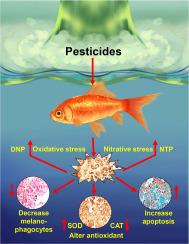Effects of short-term exposure to environmentally relevant pesticides mixture on morphological alterations, oxidative-nitrative stress biomarkers, cellular apoptosis, and antioxidant expression in kidneys of goldfish
IF 4.3
3区 环境科学与生态学
Q2 BIOCHEMISTRY & MOLECULAR BIOLOGY
Comparative Biochemistry and Physiology C-toxicology & Pharmacology
Pub Date : 2025-09-01
DOI:10.1016/j.cbpc.2025.110337
引用次数: 0
Abstract
Chemical stressors are pervasive, affecting both terrestrial and aquatic environments. The continual influx of these toxins is damaging ecosystems and the organisms that inhabit them. The abundance of environmental toxins makes aquatic habitats inhospitable for aquatic life. These chemical stressors consistently disrupt the life processes of aquatic organisms, particularly their physiological functions. This study examined on the effects of environmentally relevant pesticides mixture (low-dose and high-dose: S-metolachlor: 2.4 go/L, 12 μg/L; linuron: 2.0 μg/L, 10 μg/L; isoproturon: 1.2 μg/L, 6.0 μg/L; tebucanozole: 1.2 μg/L, 6.0 μg/L; aclonifen: 0.8 μg/L, 4.0 μg/L; atrazine: 0.4 μg/L, 2.0 μg/L; pendimethalin: 0.4 μg/L, 2.0 μg/L, and azinphos-methyl: 0.8 μg/L, 4.0 μg/L) on tissue morphology, cellular apoptosis, and nitrotyrosine protein (NTP), dinitrophenyl protein (DNP), renin, superoxide dismutase (SOD), and catalase (CAT) expression in the kidneys of goldfish (Carassius auratus) exposed for one week under controlled laboratory conditions. Histopathological analysis revealed severe tissue damage in the kidneys, while silver staining identified melano-macrophage centers, and immunohistochemistry and real-time PCR shed light on the expression of molecular biomarkers in these tissues. Exposure to pesticide mixtures caused fish to exhibit glomerular shrinkage, enlargement of Bowman's space, and degradation of glomerular cells. Moreover, the expression of renin, DNP, NTP, SOD, and apoptotic nuclei increased in kidney tissues, while CAT expression decreased. Overall, our findings indicate that exposure of goldfish to an environmentally relevant pesticide mixture leads to increased cellular damage and altered osmoregulatory and antioxidant enzyme expressions, which may impair physiological functions, including growth, reproduction, and development in teleost fish.

短期暴露于环境相关农药混合物对金鱼肾脏形态改变、氧化-硝化应激生物标志物、细胞凋亡和抗氧化剂表达的影响
化学压力源无处不在,影响着陆地和水生环境。这些毒素的不断涌入正在破坏生态系统和栖息在其中的生物。丰富的环境毒素使水生生物的栖息地不适宜生存。这些化学应激源不断破坏水生生物的生命过程,特别是它们的生理功能。这项研究检查了相关环保农药混合物的影响(低剂量和高剂量:S-metolachlor: 2.4 / L, 12 μg / L;利谷隆: 2.0μg / L, 10 μg / L; isoproturon: 1.2μg / L, 6.0μg / L; tebucanozole: 1.2μg / L, 6.0μg / L; aclonifen: 0.8μg / L, 4.0μg / L;莠去津: 0.4μg / L, 2.0μg / L;在实验室条件下,二甲萘:0.4 μg/L, 2.0 μg/L,甲基氮磷:0.8 μg/L, 4.0 μg/L,对鲫鱼(Carassius auratus)肾脏组织形态、细胞凋亡及硝基酪氨酸蛋白(NTP)、二硝基苯蛋白(DNP)、肾素、超氧化物歧化酶(SOD)、过氧化氢酶(CAT)表达的影响。组织病理学分析显示肾脏严重的组织损伤,而银染色鉴定了黑素巨噬细胞中心,免疫组织化学和实时PCR揭示了这些组织中分子生物标志物的表达。暴露于农药混合物中使鱼表现出肾小球收缩、鲍曼间隙增大和肾小球细胞降解。肾组织中肾素、DNP、NTP、SOD、凋亡核表达升高,CAT表达降低。总的来说,我们的研究结果表明,金鱼暴露于与环境相关的农药混合物中会导致细胞损伤增加,渗透调节和抗氧化酶表达改变,这可能会损害硬骨鱼的生理功能,包括生长、繁殖和发育。
本文章由计算机程序翻译,如有差异,请以英文原文为准。
求助全文
约1分钟内获得全文
求助全文
来源期刊
CiteScore
7.50
自引率
5.10%
发文量
206
审稿时长
30 days
期刊介绍:
Part C: Toxicology and Pharmacology. This journal is concerned with chemical and drug action at different levels of organization, biotransformation of xenobiotics, mechanisms of toxicity, including reactive oxygen species and carcinogenesis, endocrine disruptors, natural products chemistry, and signal transduction with a molecular approach to these fields.

 求助内容:
求助内容: 应助结果提醒方式:
应助结果提醒方式:


